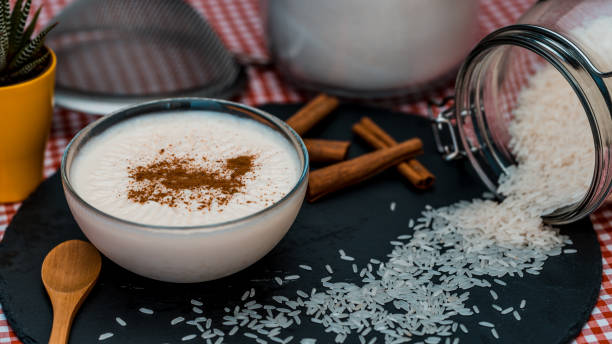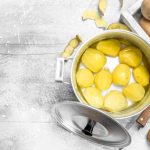Are you in search of a smooth rice pudding recipe? This is my absolute favorite rice pudding recipe, which is, to my mind, the most delicious, best, and delicious rice pudding you could make!
I’ve been making this stovetop rice pudding for years. For decades It’s easily my favorite rice pudding recipe. It takes longer than other rice desserts, making the most delicious and creamy rice pudding. It’s worth the effort!
Some are inclined to view it as a dish that isn’t very palatable; however, when done correctly, it’s as far away from being humble as it gets.
Ingredient Notes
Rice: The old-fashioned classic rice pudding is usually made using transformed long-grain rice like Uncle Ben’s(TM), and you won’t be disappointed using this kind of rice. I also love Arborio rice for rice pudding. I enjoy the plump rice grains, which cook beautifully in milk. Basmati and Jasmine are long-grain rice, which could be a viable alternative instead of the other choices. I wouldn’t suggest any other short-grain or quick-cooking rice pudding as it is more likely to produce an uncooked, mushy pudding with this long-simmering recipe.
Milk Whole, full-fat 3.5 percent b.f. It is the best to make rice pudding. You could use 2% when only 2; however, the resultant pudding won’t be as rich and creamy. I would not recommend using less than 2% milk for the best results.
Cream – The heavy whipping cream (35 percent b.f.) adds to the creamy taste of the pudding and the thickening process. I would recommend using the heavier cream. It is possible to use lighter creams in case of a need, for example, half & Half 10% cream; however, I haven’t tried it myself. I assume it will result in a less sloppy pudding, but only to a certain extent.
White Granulated sugar Sugar is added to sweeten the dish. You can alter the amount according to your preference. I recommend you make the recipe exactly as it is written and tweaking afterward. Additionally, other sweeteners can work. However, it is recommended to stick with sugar granulated if possible (vs. liquid) to avoid thinning the pudding too much.
Step-by-Step Photos
For the rice pudding to be prepared, bringing the milk up to boiling in a large pan on medium heat is necessary. Make sure you have an enormous pot and monitor closely. If the milk reaches a boiling point, it may rise and spill, extending over the top of the pan, which is not an excellent thing.
As the hot milk heats up, take the time to prepare the custard components (eggs, sugar, cream vanilla, salt, and egg). I like to start this at the beginning of the process so it gets time to chill out and cool to room temperature before serving.
When the milk is brought to the boiling temperature, mix in the rice and reduce the heat in the cooker to around medium-low or whatever setting is on your stovetop that keeps a simmer at a moderate level.
It’s necessary to stir the pudding every 10 minutes during the initial 30-minute cooking time. The milk will develop an outer layer. It is best to go in the remaining pudding.
After 30 mins of simmering, you’ll need to stir and check the rice every 5 mins, tasting and reviewing the rice after every stir until the rice is cooked. By this time, most of the liquid is absorbed, so it’s vital to stir frequently and, if needed, add a bit of boiling milk (or water) to the pot to avoid burning the rice.
Once the rice has become tender and the rice is cooked, take the pot off the temperature (to keep the rice from burning) as you slowly mix a few spoons of the warm milk/rice mixture. This should be done very slowly, one drop at a moment, which means you gradually raise the egg mix temperature to that of your rice. If you introduce too much hot liquid in one go, eggs will be cooked and look like scrambled eggs. That’s undoubtedly not what we’d like. After you’ve added two spoons of the hot rice mixture to the egg mixture, pour the egg mixture into the pan along with the rice. Then, bring the pudding back to the simmering point at medium. Cook, stirring continuously, until the combination is just breaking the bubble. Remove the pudding to an empty bowl. Refrigerate and cover for at minimum 6 hours. The pudding will get thicker when it is refrigerated.
Cook’s Notes
Please ignore the pot when your milk is coming to a boil at the beginning of cooking and then see it boil and spill all over the stove. Make sure you use a large pot and pay close attention as it gets closer to boiling (starts bubbling) to avoid that mess.
The rice and milk mixture is simmering too quickly without stirring the mixture often. Both can lead to rice burning in the middle of the saucepan or the mix drying before the rice can cook. Keep the rice at a simmer, but only barely stir it frequently. I prefer to set an alarm on the stove that runs in 10-minute increments to remind me not to forget to cook it at the table.
Too many hot liquids in the egg mixture are too fast. You must slowly increase the egg mixture’s temperature (called “tempering”) to ensure that your eggs don’t boil or curdle. Start adding one drop at a time (really!), and then whisk continuously as you add. Then, you can build up to a slower stream as you progress at first, but you should keep whisking and don’t overdo the process.
The pudding is not cooked long enough after adding eggs, resulting in a soupy pudding. It’s hard to discern at first when trying to try it after the custard is cooked enough. It is helpful to understand what result you’re looking at. It’s unlikely to look like the final product in the pictures. The pudding will look the same once it’s set and refrigerated; however, it will look more saucy once it’s off the stove. However, the sauce is supposed to be thick and creamy. It should also appear thicker – not as thin as milk. My technique is that when the pudding is nearing boiling (lots of steam rising out of the mix), I’ll take a break for a 10-15 second period and then check whether any bubbles form within the center. If none do, I continue cooking and stirring for another 30 seconds or so, after which I stop to see if bubbles begin to rise. If I notice an increase in bubbles, continue cooking and stirring for about 30-60 seconds before removing and pouring into a serving bowl.
Allowing the liquid in the pot to go too low. Because rice absorbs liquid differently,ght find that milk is mainly gone prior tbefore the rice is. If the rice becomes too dry, it could cause a fire at the base of your pan. Do not hesitate to add liquid or milk to the pot close to the cook time to ensure that the liquid is enough to keep the rice from sinking to the bottom. For the best results, use warm milk or hot water to avoid cooling the mix.



